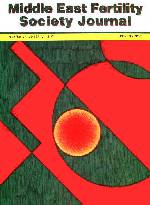
|
Middle East Fertility Society Journal
Middle East Fertility Society
ISSN: 1110-5690
Vol. 13, Num. 1, 2008, pp. 68-68
|
Middle East Fertility Society Journal, Vol.
13, No. 1, 2008, pp. 68-68
BOOK REVIEW
How to get pregnant? Sherman Silber. Little, Brown and Company, New York, Boston, London 2007.
Mohamed Aboulghar, M.D.
Professor in Obstetrics and Gynecology, Faculty of Medicine, Cairo University
Code Number: mf08016
In the preface entitled “The
Infertility Epidemic” the author discussed the importance of understanding the
biological clock of the woman and then he discussed several misleading topics
relating to the diagnosis of the cause of infertility. He stressed the
importance of age and that fertility declines with the progress of age. The
author also discusses two common factors; male factor infertility and the
presence of varicocele and its importance, and endometriosis as a disease
related to infertility. The he rapidly covers the subject of IVF and ICSI and
explained the fact that it is very important to have a top IVF lab and that
ICSI and IVF will not overcome every cause of infertility and there is no
guarantee of the results.
Again, he also explained the fact
that even azoospermic me can father children using testicular sperms. The topic
of egg donation for women with premature ovarian failure or very poor quality
oocytes or aging women was also discussed.
Then the author talked about
simple advice for women to become pregnant without resorting to medical
treatment.
He discussed in a full chapter
the physiology and anatomy of the female genital tract, ovulation and its
diagnosis and how the menstrual cycle is controlled and how eggs are produced
and which hormone control it and the number of chromosomes present in each egg.
The author discusses
the frequency and timing of sexual relation in relation to pregnancy rate. He
also discussed infectious diseases and their effect on infertility. He devoted
one whole chapter for decreased fertility of the woman by age and the low
reserve of eggs in certain number of women and the possibility of freezing oocytes
for future use and the technical difficulties in that. He then discussed
different methods for accessing ovarian reserve and he particularly talked
about the antral follicle count using ultrasound. There was another chapter
devoted to simple lines of treatment which could simply be a good advice about
the time of ovulation and simple treatment for ovulation induction like
clomiphene citrate or bromocriptine if there is hyperprolactinemia. In this
chapter he also discussed different lines of treatment of endometriosis. Tests
of ovulation were discussed in details, as well as testing the patency of the
tube by hysterosalpingography.
There is another chapter on
emotions and infertility and the effect of anxiety on the outcome of pregnancy.
Another chapter was devoted to the male and how sperms are produced and
ejaculated, and the count of sperms. From this the authors moves us to
intrauterine insemination which is combined with ovarian stimulation. How
sperms are prepared and washed, different methods of stimulation and timing of
IUI. Then he moves to IVF with details on the technique starting from
preparation of the patient, ovarian stimulation, embryo culture technique and
then intracytoplasmic sperm injection. Also the technique of embryo transfer
was discussed together with prolonged culture resulting in blastocyst transfer
and the possible value of assisted hatching.
The author in another chapter
discussed the outcome of pregnancy and if the baby is normal and chances of
congenital malformation and chromosomal abnormalities in babies born after IVF
and ICSI and he showed that there is a slight increase in both anomalies and
chromosomal aberrations. He also discussed preimplantation genetic diagnosis,
its technique, value and limitation. Then there is another chapter devoted to
miscarriage and he particularly discussed the chromosomal errors causing
miscarriage.
The last chapter is devoted to
controversies over IVF, cloning and stem cell.
This is a very interesting book
which is suitable for the general reader, however, medical specialist would
also enjoy reading it.
©Copyright 2008 - Middle East Fertility Society
| 